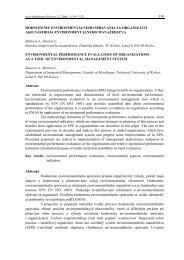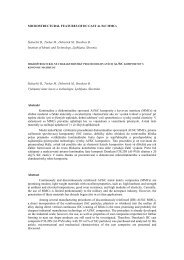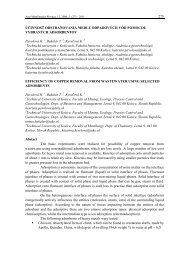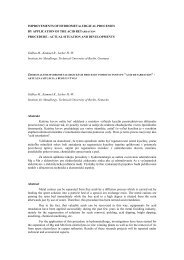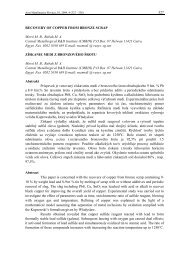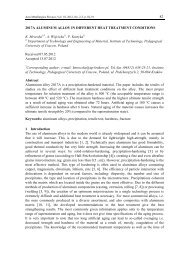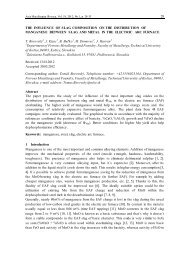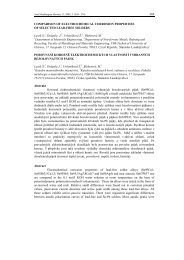a structural model for the rusting of reduced ilmenite - Acta ...
a structural model for the rusting of reduced ilmenite - Acta ...
a structural model for the rusting of reduced ilmenite - Acta ...
You also want an ePaper? Increase the reach of your titles
YUMPU automatically turns print PDFs into web optimized ePapers that Google loves.
<strong>Acta</strong> Metallurgica Slovaca, 9, 2003, 1 (13 - 20 ) 13A STRUCTURAL MODEL FOR THE RUSTING OF REDUCED ILMENITEKumari E.Jaya, Das P.N.MohanRegional Research Laboratory (CSIR), Trivandrum 695019, Indiae-mail: pnmd@csrrltrd.ren.nic.in, daspnm@rediffmail.comŠTRUKTÚRNY MODEL ODŽELEZENIA REDUKOVANÉHO ILMENITUKumari E.Jaya, Das P.N.MohanRegional Research Laboratory (CSIR), Trivandrum 695019,e-mail: pnmd@csrrltrd.ren.nic.in, daspnm@rediffmail.com, IndiaAbstraktV novom komerčnom procese výroby syntetického rutilu je kovové železo prítomné vredukovanom <strong>ilmenite</strong> oxidované na pevný oxid železa použitím chloridu amónneho. Pretožeoxidačný proces je veľmi pomalý v prítomnosti chloridu amónneho je potrebné ho urýchliť.Preto sa realizovali experimenty na overenie vplyvu organických zlúčenín. Bolo pozorované, ženiektoré organické zlúčeniny ako metanol a acetón v kombinácii s kyselinou mravčou keď sapoužijú v prítomnosti chloridu amónneho mali veľmi pozitívny vplyv na priebeh chemickejreakcie. Boli preštudované vplyvy rôznych experimentálnych parametrov, ktoré ovplyvňujúreakciu oxidácie. Študovala sa i kinetika reakcie a bolo realizované <strong>model</strong>ovanie jej priebehu.Zistilo sa, že reakcia bola kontrolovaná aj rýchlosťou chemickej reakcie aj difúznymi procesmi.AbstractIn <strong>the</strong> new commercially followed process <strong>for</strong> <strong>the</strong> production <strong>of</strong> syn<strong>the</strong>tic rutile,metallic iron present in <strong>the</strong> <strong>reduced</strong> <strong>ilmenite</strong> is oxidized to solid iron oxide using NH 4 Cl ascatalyst. There is necessity <strong>for</strong> improving <strong>the</strong> oxidation process, which is very slow in presence<strong>of</strong> NH 4 Cl. Attempts were hence made to study <strong>the</strong> effects <strong>of</strong> various organic compounds with aview to accelerate <strong>the</strong> reaction. It was observed that certain organic compounds like methanoland acetone in combination with <strong>for</strong>mic acid when used along with NH 4 Cl had very positiveinfluence on <strong>the</strong> reaction. The influence <strong>of</strong> various experimental parameters on <strong>the</strong> oxidationreaction was investigated. Kinetics <strong>of</strong> <strong>the</strong> reaction was studied and <strong>the</strong> <strong>model</strong>ling <strong>of</strong> <strong>the</strong> reactionwas carried out. It was observed that <strong>the</strong> reaction was chemically as well as diffusion controlled.Key words: syn<strong>the</strong>tic rutile, <strong>ilmenite</strong>, <strong>rusting</strong>, <strong>model</strong>ing catalytic oxidationIntroductionIlmenite (FeTiO 3 ), which is an ore <strong>of</strong> titanium, is present abundantly along <strong>the</strong> coasts <strong>of</strong>Kerala, Tamil Nadu, Andhra Pradesh and Orissa. Due to <strong>the</strong> scarcity <strong>of</strong> natural rutile and cost,beneficiated ilmente has gained importance as a raw material <strong>for</strong> <strong>the</strong> production <strong>of</strong> titaniummetal and pigment through chloride route. Lot <strong>of</strong> investigations were carried out <strong>for</strong>beneficiating <strong>ilmenite</strong>. But many <strong>of</strong> <strong>the</strong>m suffer from pollution problems as all <strong>the</strong> iron isleached out with acid. A new process developed by RRL [1] is highly environment friendlywhich has <strong>the</strong> following steps. Reduction, <strong>rusting</strong>, rutilation and acid wash. In this process<strong>ilmenite</strong> is subjected to carbo<strong>the</strong>rmic reduction followed by <strong>rusting</strong> in presence <strong>of</strong> a catalyst. In
<strong>Acta</strong> Metallurgica Slovaca, 9, 2003, 1 (13 - 20 ) 14<strong>the</strong> <strong>rusting</strong> step <strong>the</strong> <strong>reduced</strong> <strong>ilmenite</strong> is subjected to oxidation by suspending it in NH 4 Cl solutionfollowed by aeration when <strong>the</strong> iron oxide comes out, which can be separated. The majordisadvantage <strong>of</strong> <strong>the</strong> above process is that <strong>the</strong> <strong>rusting</strong> is most time consuming step, which takesabout 16 hrs <strong>for</strong> completion. Detailed investigations were carried out to accelerate <strong>the</strong> abovereaction with a view to reduce <strong>the</strong> reaction time. This paper highlights <strong>the</strong> results <strong>of</strong>investigations carried out using mixtures <strong>of</strong> CH 3 COCH 3 + HCOOH and CH 3 OH + HCOOHalong with NH 4 Cl [2-4].Experimental ProcedureReduced Quilon <strong>ilmenite</strong> having 76% metallisation was used <strong>for</strong> <strong>the</strong> experiments.Laboratory grade and A.R. grade chemicals were used <strong>for</strong> experiments and chemical analysisrespectively.125 gm <strong>of</strong> <strong>reduced</strong> <strong>ilmenite</strong> was suspended in 500 ml <strong>of</strong> aqueous solution <strong>of</strong> 1.5%NH 4 Cl catalyst. Air at <strong>the</strong> rate <strong>of</strong> 4-5 lit/min was bubbled through <strong>the</strong> solution, while it was keptstirred at 800 rpm using a mechanical stirrer. 2% acetone or methanol and 1% <strong>for</strong>mic acid wereadded.Ilmenite samples were withdrawn at regular intervals <strong>of</strong> time and <strong>the</strong> reaction wasallowed to run <strong>for</strong> 4 hrs.Chemical analysis <strong>of</strong> <strong>the</strong> compounds were carried out using standard procedures [5].XRD studies were done using a Philip’s X – ray diffractometer while JSM 5600scanning electron microscope was used <strong>for</strong> SEM studies.Results and DiscussionThe chemical reactions taking place during <strong>the</strong> <strong>rusting</strong> reaction areFe ⇒ Fe 2+ + 2 e -Fe ⇒ Fe 3+ + 3 e -O 2 + H 2 O + 4 e- ⇒ 4 OH –Fe 2+ + 2 (OH) - ⇒ Fe(OH) 2Fe 3+ + 3(OH) - ⇒ Fe(OH) 3Fig 1 gives <strong>the</strong> plot <strong>of</strong> time vs. % iron removal using NH 4 Cl, NH 4 Cl + acetone + <strong>for</strong>micacid and NH 4 Cl + methanol + <strong>for</strong>mic acid.When NH 4 Cl alone was used as <strong>the</strong> catalyst an iron removal <strong>of</strong> 51% was observed in 4hrs and <strong>the</strong>n <strong>the</strong> reaction passivated. When CH 3 COCH 3 + HCOOH or CH 3 OH + HCOOH wereadded along with NH 4 Cl during <strong>rusting</strong> <strong>the</strong> reaction was very fast and <strong>the</strong> reaction was more lesscomplete within 3 hrs. 86% removal <strong>of</strong> iron was observed when CH 3 OH + HCOOH was addedalong with NH 4 Cl. 90% iron was removed in 3 hrs when CH 3 COCH 3 + HCOOH was addedalong with NH 4 Cl.The major phases present in <strong>the</strong> <strong>reduced</strong> <strong>ilmenite</strong> are anatase, pseudo brookite andmetallic iron. In <strong>the</strong> rusted <strong>ilmenite</strong> using <strong>the</strong> above carboxyl compounds along with NH 4 Cl <strong>the</strong>
<strong>Acta</strong> Metallurgica Slovaca, 9, 2003, 1 (13 - 20 ) 15major phase is anatase. The metallic iron peak has become insignificant confirming that it hasbeen converted to iron oxide or hydroxide.Fig.1 Plot <strong>of</strong> time vs % iron removalThe SEM pictures <strong>of</strong> <strong>the</strong> rusted <strong>ilmenite</strong> shows a highly porous structures having interconnected plate like <strong>for</strong>mation <strong>for</strong>med because <strong>of</strong> <strong>the</strong> removal <strong>of</strong> iron entity from <strong>the</strong> structure.This clearly confirms <strong>the</strong> removal <strong>of</strong> iron from <strong>the</strong> <strong>ilmenite</strong> particle during <strong>rusting</strong>.The <strong>model</strong>ling <strong>of</strong> <strong>the</strong> reaction was carried out as follows.A (fluid) + bB (solid) ⇒cC (fluid) + dD (solid)In a porous solid <strong>the</strong> reaction occurs in a diffuse zone ra<strong>the</strong>r than a sharp interface. Letus assume <strong>the</strong> porous solid to be an aggregate <strong>of</strong> fine grains having <strong>the</strong> shape <strong>of</strong> spheres. Thereis a gradual change in conversion <strong>of</strong> solid over <strong>the</strong> pellet. The external layer will be completelyreacted first and <strong>the</strong> thickness <strong>of</strong> <strong>the</strong> completely reacted layer will grow towards <strong>the</strong> interior <strong>of</strong><strong>the</strong> porous solid.When pore diffusion is fast compared with <strong>the</strong> rate <strong>of</strong> chemical reaction, <strong>the</strong>concentration <strong>of</strong> fluid is uni<strong>for</strong>m throughout <strong>the</strong> pellet and <strong>the</strong> reaction occurs at a uni<strong>for</strong>m rate.If chemical kinetics is much faster than <strong>the</strong> rate <strong>of</strong> diffusion <strong>the</strong> reaction occurs in a narrowregion between <strong>the</strong> unreacted and <strong>the</strong> completely reacted zones. We have <strong>for</strong>mulated equationsincluding both chemical kinetics and diffusion and derived <strong>the</strong> criteria <strong>for</strong> asymptotic regimes
<strong>Acta</strong> Metallurgica Slovaca, 9, 2003, 1 (13 - 20 ) 16where a particular step controls <strong>the</strong> overall rate. The explanations and steps <strong>for</strong> <strong>model</strong>ing are asgiven below are in line with <strong>the</strong> work reported by Sohn and Szekely [6,7].Ma<strong>the</strong>matical <strong>for</strong>mulationLet us consider a porous pellet <strong>of</strong> volume V p and <strong>of</strong> superficial area A, made up <strong>of</strong>individual particles (grains) having volume and surface area V g and A g respectively. The shape<strong>of</strong> <strong>the</strong> grains as well as <strong>the</strong> pellet is considered as spheres.It is assumed that <strong>the</strong> solid pellet, which is an agglomeration <strong>of</strong> spherical grains, reactswith air and catalysts irreversibly.A (gas + catalysts) + bB (solid)⇒ ProductsThe additional assumptions are also made as1. The pseudo-steady state approximation is valid <strong>for</strong> determining <strong>the</strong> concentration pr<strong>of</strong>ile<strong>of</strong> <strong>the</strong> fluid reactant within <strong>the</strong> pellet [8,9].2. The resistance due to external mass transfer is negligible.3. Intrapellet diffusion is ei<strong>the</strong>r equimolar counter diffusion or occurs at low concentrations<strong>of</strong> diffusing species.4. Diffusivities are constant throughout <strong>the</strong> pellet.5. Diffusion throughout <strong>the</strong> product layer around <strong>the</strong> individual grains is not rate limiting.6. The solid structure is macroscopically uni<strong>for</strong>m and is unaffected by <strong>the</strong> reaction.The assumptions are discussed as follows.Assumption (1) is acceptable <strong>for</strong> gas solid systém [10,11]. Ishida and Wen [12] have shown <strong>the</strong>external mass transfer is negligible if <strong>the</strong> pellet Sherwood number, kmR 0 /D e is greater than 100.The assumptions (3,4 and 6) are thought to be <strong>the</strong> problems <strong>of</strong> practical interest. It is safe toneglect <strong>the</strong> effect <strong>of</strong> diffusion through <strong>the</strong> product layer, because <strong>of</strong> small size <strong>of</strong> grains.The conservation <strong>of</strong> fluid reaction is represented asD e ∇ 2 C A - υ A = 0 (1)Where D e is <strong>the</strong> effective diffusion co-efficient within <strong>the</strong> porous medium, C A is <strong>the</strong> reactantconcentration and υ A is <strong>the</strong> local rate <strong>of</strong> consumption <strong>of</strong> A.Within each grain, <strong>the</strong> conservation <strong>of</strong> solid reactant may be described asρ B (-∂r c / ∂t) = bkC A (2)Where, ρ B is <strong>the</strong> density <strong>of</strong> <strong>reduced</strong> <strong>ilmenite</strong>, r is <strong>the</strong> distance co-ordinate perpendicular to <strong>the</strong>moving reaction front, b is <strong>the</strong> stoichiometric factor and k is <strong>the</strong> reaction rate constant.An expression <strong>for</strong> υ A may be obtained by determining <strong>the</strong> surface area <strong>for</strong> reactionavailable per unit volume <strong>of</strong> <strong>the</strong> pellet.υ A = α β k (A g /V g ) (A g r c / F g V g ) Fg –1 C A (3)Where, α β is <strong>the</strong> volume fraction <strong>of</strong> <strong>the</strong> pellet occupied by solid B, A g is <strong>the</strong> external surface <strong>of</strong>an individual grain, V g is <strong>the</strong> volume <strong>of</strong> <strong>the</strong> grain, F g is <strong>the</strong> shape factor. Shape factor <strong>for</strong> sphereis 3.
<strong>Acta</strong> Metallurgica Slovaca, 9, 2003, 1 (13 - 20 ) 17‘Equation (1) and (2)’ can be expressed in dimensionless <strong>for</strong>m <strong>for</strong> introducingdimensionless variables [13].Ψ ≡ C A / C AB (4)ξ ≡ A g r c / F g V g = r c / r g (5)t* ≡ (bkC AB A g / ρ B F g V g ) t (6)η ≡ A p R / F p V p = R / R p (7)σ ≡ F p V p /A p (α β kA g / D e V g ) 1/2 (8)t is <strong>the</strong> total time <strong>of</strong> reaction, F p Shape factor <strong>of</strong> <strong>the</strong> pellet ie, 3. A p external surface area <strong>of</strong> <strong>the</strong>pellet (4Πr 2 = 1 already assumed), V p Volume <strong>of</strong> <strong>the</strong> pellet, R is <strong>the</strong> distance from <strong>the</strong> centre <strong>of</strong>symmetry in <strong>the</strong> pellet.The dimensionless <strong>for</strong>m <strong>of</strong> equation (1) and (2) is∇* 2 Ψ - σ 2 Ψ ξ Fg-1 = 0 (9)∂ξ / ∂t* = - Ψ (10)Where, ∇* is <strong>the</strong> Laplacian operator with η as <strong>the</strong> position co-ordinate.The initial boundary conditions <strong>for</strong> ‘equations (9) and (10)’ areξ = 1 at t* = 0 (11)Ψ = 1 at η = 1 (12)∂Ψ / ∂η = 0 at η = 0 (13)η is <strong>the</strong> length co-ordinate in ∇ operator (13).In terms <strong>of</strong> <strong>the</strong> parameters used in <strong>the</strong> <strong>for</strong>mulation <strong>the</strong> overall extent <strong>of</strong> <strong>the</strong> reaction isdefined asX = ∫ η Fp-1 (1- ξ Fg ) ∂η / ∫η Fp – 1 ∂η (14)The dimensionless representation governing equation shows <strong>the</strong> dependent variables ξand Ψ are related to t* and η and <strong>the</strong> single parameter which appears in <strong>the</strong> <strong>for</strong>mulation as σ.The quantity <strong>of</strong> σ incorporates both <strong>structural</strong> and kinetic parameters.Asymptotic BehaviourWhen σ approaches zero, <strong>the</strong> overall rate is controlled by chemical kinetics, anddiffusion within <strong>the</strong> pellet is rapid compared with <strong>the</strong> rate <strong>of</strong> <strong>the</strong> chemical reaction. Fur<strong>the</strong>r ξ isindependent <strong>of</strong> η, although still a function t*. Under <strong>the</strong>se conditions equation (10) is readilyintegrated to obtainξ = 1 – t* <strong>for</strong> 0 ≤ t* ≤ 1
<strong>Acta</strong> Metallurgica Slovaca, 9, 2003, 1 (13 - 20 ) 18and ξ = 0 <strong>for</strong> t* ≥ 1 (15)Using equation (14) we get relationship between X and t*t* = 1- (1-X) 1/Fg ≡ gF g (X) (16)gF g (X) refers to <strong>the</strong> value <strong>of</strong> t* within asymptotic regime where σ → 0. Fromexperimental data it is understood diffusion within <strong>the</strong> pellet was not rate controlling.(ii) When σ approaches infinityThe overall rate is controlled by <strong>the</strong> diffusion <strong>of</strong> <strong>the</strong> gaseous reactant within <strong>the</strong> pellet.This corresponds to <strong>the</strong> shrinking core <strong>model</strong>.P Fp (X) = 2 F p bD e C AB / α β ρ B (A p / F p V p ) 2 t (17)2F g F p / σ 2 t* = t* / σ ^2 (18)Where σ ^2 = σ 2 / 2F g F pEquation (17) provides a convenient means <strong>of</strong> determining <strong>the</strong> effective diffusivity by plottingexperimental data obtained under diffusion control.σ ^ = σ / (2F g F p ) 1/2 = V p / A p [α β kF p / 2D e (A g / F g V g )] 1/2 (19)Analytical SolutionsEquation (16) and (18) correspond to asymptotic solutions <strong>for</strong> pure chemical controland pure diffusion control respectively.Since <strong>the</strong> grains are spherical F g =3 equation (9) becomes(∂ 2 / ∂η 2 - σ ξ 2 ) Ψ = 0 (9a)Ψ = cos h (σ ξ η) / cos h (σ ξ) (20)∂ξ / ∂t* = -Ψ (10)= t* [1- cos h (σ ξ η) / cos h (σ ξ)] (21)The time required to achieve <strong>the</strong> complete reaction <strong>of</strong> <strong>the</strong> pellet ist* x=1 = 1 + σ ^2 (22)The rate <strong>of</strong> reaction is independent <strong>of</strong> <strong>the</strong> solid reaction concentration.The reaction <strong>of</strong> a porous solid with a fluid involves chemical reaction and intrapelletdiffusion occurring in parallel. The grain <strong>model</strong> is <strong>the</strong> recent development in this area. The<strong>model</strong>s have been tested against experiments and found to describe <strong>the</strong> reaction <strong>of</strong> porous solidsreasonably well.The experimental values were tested with <strong>the</strong> equations obtained through <strong>the</strong>development <strong>of</strong> <strong>structural</strong> <strong>model</strong> and was verified by plotting in <strong>the</strong> graphs. Fig.2, 3 and 4 showthat, <strong>the</strong> <strong>structural</strong> <strong>model</strong> goes in hand with <strong>the</strong> experimental value.
<strong>Acta</strong> Metallurgica Slovaca, 9, 2003, 1 (13 - 20 ) 19Fig.2 Conversion function vs. Reduced time <strong>for</strong> small <strong>of</strong> σFig.3 Conversion function vs. <strong>reduced</strong> time <strong>for</strong> largevalues <strong>of</strong> σFig.4 Comparison <strong>of</strong> approximate solution with exact solution
<strong>Acta</strong> Metallurgica Slovaca, 9, 2003, 1 (13 - 20 ) 20The straight line obtained by plotting t* vs. gF g (X) = 1-(1-X) 1/3 proves that <strong>the</strong> reactionis controlled by surface chemical or topochemical.The graph obtained by plotting t*/ σ Λ2 vs. pF p (X) = 1+2(1-X)-3(1-X) 2/3 is an evidence<strong>of</strong> <strong>the</strong> diffusion controlled reaction. There is good agreement between <strong>the</strong> <strong>model</strong> developed and<strong>the</strong> experimental data, which shows that <strong>the</strong> <strong>model</strong> developed is correct and suitable.The graph obtained by plotting t* vs. conversion (X) is also similar to <strong>the</strong> one which weexpect from <strong>the</strong> <strong>the</strong>oretical data.ConclusionThe following conclusions can be drawn from <strong>the</strong> results <strong>of</strong> <strong>the</strong> above investigations.1. The mixtures <strong>of</strong> methanol and <strong>for</strong>mic acid along with NH 4 Cl are more efficient <strong>for</strong> <strong>the</strong>iron removal from <strong>reduced</strong> <strong>ilmenite</strong>2. Acetone <strong>for</strong>mic acid mixture is better than methanol and <strong>for</strong>mic acid as a catalyst.3. About 90% <strong>of</strong> iron removal could be achieved using acetone and <strong>for</strong>mic acid in place <strong>of</strong>51% <strong>for</strong> NH 4 Cl alone.4. The product obtained after <strong>rusting</strong> had a TiO 2 content <strong>of</strong> 95.85% after <strong>rusting</strong> <strong>for</strong> 3 hrs.5. XRD and SEM studies show <strong>the</strong> <strong>structural</strong> and morphological changes taking placeduring <strong>rusting</strong>.6. Modeling studies confirm that <strong>the</strong> reaction is diffusion as well as chemically controlled.AcknowledgementsWe express our sincere thanks to Dr.Vijay Nair, Director, RRL, Trivandrum andCouncil <strong>of</strong> Scientific and Industrial Research, New Delhi <strong>for</strong> <strong>the</strong> facilities and fellowship.Literature[1] Mohan Das, P.N., Damodaran, A.D., Bhat, K.H., Velusamy, S. and Sasibhushanan, S.,Indian Patent 1262 / DEL /97[2] Jaya Kumari, E., Peter Koshy and Mohan Das, P.N., Investigations on <strong>the</strong> effect <strong>of</strong> certaincarbonyl compounds on <strong>the</strong> removal <strong>of</strong> iron during <strong>the</strong> <strong>rusting</strong> <strong>of</strong> <strong>reduced</strong> <strong>ilmenite</strong>, Trans.Indian Inst. Met., Vol. 53, No. 6, pp 573 – 579, 2000[3] Kumari, E.J., Bhat, K.H., Sasibhushanan, S. and Mohan Das, P.N., Catalytic Removal <strong>of</strong>Iron from Ilmenite, Minerals Engineering, Vol 14, No. 3, p 365 – 368, 2001[4] Mohan Das, P.N., Jaya Kumari, E., Sasibhushanan, S. and Kochu Janaki M.E., IndianPatent 317 / DEL / 98[5] Vogel’s Textbook <strong>of</strong> Quantitative Chemical Analysis (ELBS 5 th Ed, 1989) p 376[6] Sohn H.Y. and Szekely, The effect <strong>of</strong> intragrain diffusion on <strong>the</strong> reaction between a poroussolid and a gas, J. Chem.Engg. Sci. Vol. 29, p 630 –634, 1974[7] Sohn H.Y. and Szekely, A <strong>structural</strong> <strong>model</strong> <strong>for</strong> gas – solid reactions with a movingboundary – IV Langumir – Hinshelwood Kinetics, J. Chem.Engg. Sci. 28,1169 – 1177, 1973[8] Bisc<strong>of</strong>f K.B., Chem.Engg. 18, 711 (1963), 20, 783 (1965)[9] Luss D. Can. J. Chem.Engg., 46, 154 (1968)[10] Reid R.C and Sherwood T.K., Properties <strong>of</strong> gases and liquids, 2 nd Ed; Mc Graw – Hill, NewYork (1966)[11] Smith J.M., Chemical Engg. Kinetics, 2 nd Ed; Mc Graw – Hill, New York (1970)[12] Ishida M. and Wen C.Y.: A.I.Ch.E., J (1968) 14, 311[13] Hem Shanker Ray, Kinetics <strong>of</strong> Metallurgical Reactions; Ox<strong>for</strong>d & IBH Publishing Co. Pvt.Ltd., New Delhi (1993), p 59 & 78



